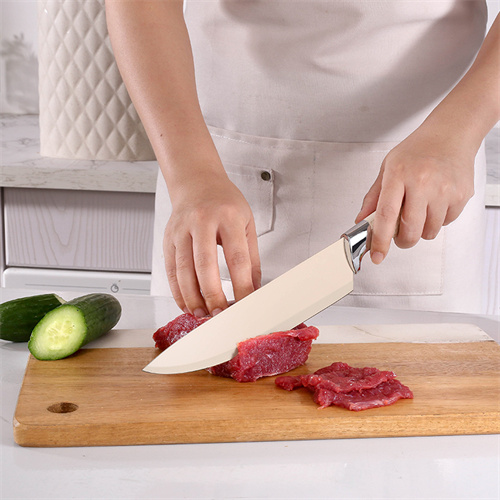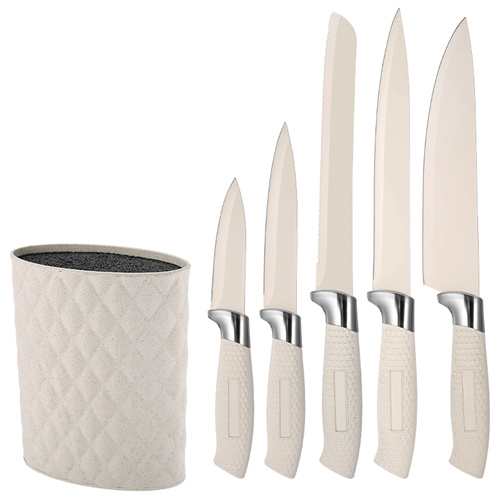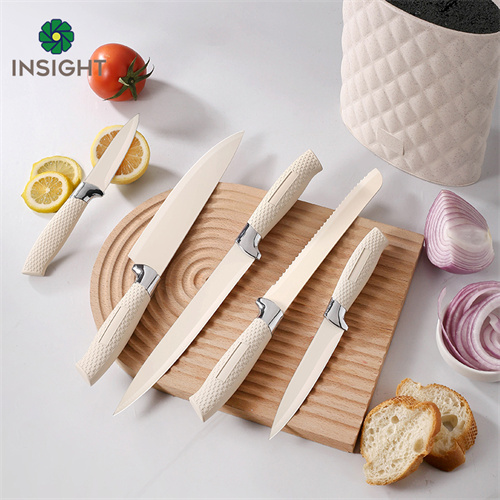

Views: 780 Author: sales@insightknife.com.cn Publish Time: 2025-02-10 Origin: Site








Content Menu
● Understanding Your Bread Knife
>> The Design of a Bread Knife
>> Importance of Cleaning Your Bread Knife
● Best Practices for Cleaning Your Bread Knife
>> Immediate Cleaning After Use
>>> Steps for Immediate Cleaning
>>> Soaking Method
● Maintaining Your Bread Knife
● Frequently Asked Questions regarding Bread Knife
>> 1. How often should I clean my bread knife?
>> 2. Can I use a dishwasher to clean my bread knife?
>> 3. What is the best way to sharpen a bread knife?
>> 4. Is it necessary to oil my bread knife?
>> 5. What should I do if my bread knife has rust spots?
Cleaning kitchen knives, especially specialized ones like bread knives, is essential for maintaining their performance and longevity. Bread knives, with their serrated edges, require specific care to ensure they remain sharp and effective. This article will explore the best practices for cleaning your bread knife, including methods, tips, and maintenance strategies.
A bread knife typically features a long, serrated blade designed to slice through crusty bread without crushing it. The serrations allow for a sawing motion, making it easier to cut through tough exteriors while preserving the soft interior of the bread. Understanding this design is crucial for proper cleaning and maintenance. The length of the blade often ranges from 8 to 10 inches, providing ample reach for larger loaves. The serrated edge is not just for aesthetics; it is engineered to grip the crust and slice through it efficiently, which is why using a regular knife can lead to squished bread.
Regular cleaning of your bread knife is vital for several reasons. First, it prevents the buildup of food particles and bacteria, which can lead to contamination. Bread, especially when fresh, can leave behind crumbs and moisture that promote bacterial growth. Second, it helps maintain the knife's sharpness and effectiveness. A clean knife cuts better, ensuring that each slice is smooth and even. Lastly, proper care can extend the life of your knife, saving you money in the long run. A well-maintained knife not only performs better but also enhances your overall cooking experience, making meal preparation more enjoyable.
One of the best practices for maintaining your bread knife is to clean it immediately after use. This prevents food residue from drying on the blade, which can make cleaning more difficult later.
Rinse the Knife: After slicing bread, rinse the knife under warm running water. This helps remove any crumbs or residue. Warm water is effective in loosening any stuck particles without damaging the blade.
Use Mild Soap: Apply a small amount of mild dish soap to a soft sponge or cloth. Avoid using abrasive materials that can scratch the blade. A gentle soap will effectively clean without harming the knife's finish.
Wipe the Blade: Gently wipe the blade from the dull side to the sharp edge. This technique helps prevent injury and maintains the integrity of the serrations. Always handle the knife with care, as the serrated edges can be sharp and pose a risk of cuts.
Rinse Again: Rinse the knife thoroughly under warm water to remove all soap residue. Ensuring that no soap remains is crucial, as it can affect the taste of the food during the next use.
Dry Immediately: Use a clean towel to dry the knife immediately. Avoid air drying, as this can lead to rust formation. Proper drying is essential, especially for knives with metal components, to prevent moisture from causing corrosion.

While immediate cleaning is essential, there are times when a deeper clean is necessary, especially if the knife has been used for sticky or greasy substances.
For stubborn residues, consider soaking the knife:
Fill a Basin with Warm Soapy Water: Ensure the water is not too hot, as extreme temperatures can damage the handle. A comfortable temperature will help loosen grime without risking damage.
Submerge the Knife: Place the knife in the soapy water, ensuring the blade is fully submerged but the handle remains above water. This prevents water from seeping into the handle, which can weaken it over time.
Let it Soak: Allow the knife to soak for a few minutes to loosen any stuck-on food. This soaking time is crucial for breaking down tough residues.
Gently Scrub: After soaking, use a soft sponge to gently scrub the blade, focusing on any areas with residue. Be careful around the serrations, as they can trap food particles.
Rinse and Dry: Rinse thoroughly and dry immediately. Ensuring the knife is completely dry will help maintain its condition and prevent rust.
When cleaning your bread knife, there are several common mistakes to avoid:
While it may be tempting to toss your bread knife in the dishwasher, this can lead to damage. The high heat and harsh detergents can dull the blade and damage the handle. Always opt for hand washing. Dishwashers can also cause knives to knock against other utensils, leading to nicks and scratches on the blade.
Many people focus solely on the blade and neglect the handle. It’s important to clean the handle as well, as it can harbor bacteria and food particles. Use a damp cloth to wipe down the handle after cleaning the blade. This step is often overlooked but is essential for overall hygiene and knife maintenance.

To keep your bread knife performing at its best, regular sharpening is essential. A dull knife can be more dangerous and less effective. Use a honing rod or take it to a professional for sharpening as needed. Regular honing can help maintain the edge between professional sharpenings, ensuring that your knife remains effective for slicing through crusty bread.
Applying a thin layer of food-grade mineral oil to the blade can help protect it from moisture and rust. This is especially important if you live in a humid environment. Oiling not only protects the blade but also enhances its appearance, giving it a polished look. Be sure to wipe off any excess oil before using the knife to avoid transferring it to your food.
How you store your bread knife can also affect its longevity. Consider the following storage options:
Knife Block: A knife block keeps the blade protected and easily accessible. This method also prevents the knife from coming into contact with other utensils, which can dull the blade.
Magnetic Strip: This allows for easy access while keeping the blade safe from damage. A magnetic strip can also serve as a decorative element in your kitchen.
Blade Guards: If you must store your knife in a drawer, use a blade guard to protect the edge. Blade guards are especially useful for serrated knives, as they help maintain the sharpness of the serrations.
Cleaning and maintaining your bread knife is crucial for its performance and longevity. By following the best practices outlined in this article, you can ensure that your knife remains sharp, effective, and safe to use. Regular cleaning, proper storage, and maintenance will not only enhance your cooking experience but also extend the life of your kitchen tools. Remember, a well-cared-for knife is a joy to use and an essential tool in any kitchen. Investing time in the care of your bread knife will pay off in the quality of your food preparation and the enjoyment of your culinary endeavors.

You should clean your bread knife after every use to prevent food residue from building up. This immediate cleaning helps maintain hygiene and keeps the knife in good condition.
No, it is not recommended to use a dishwasher for cleaning your bread knife. The high heat and harsh detergents can dull the blade and damage the handle. Hand washing is the best method.
The best way to sharpen a bread knife is to use a honing rod or take it to a professional knife sharpener. Regular honing can help maintain the edge, while professional sharpening should be done as needed.
Yes, applying a thin layer of food-grade mineral oil to the blade can help protect it from moisture and rust, especially in humid environments. Just be sure to wipe off any excess oil before using the knife.
If your bread knife has rust spots, you can remove them by gently scrubbing the affected area with a mixture of baking soda and water. After cleaning, rinse the knife thoroughly, dry it immediately, and consider applying oil to prevent future rust.